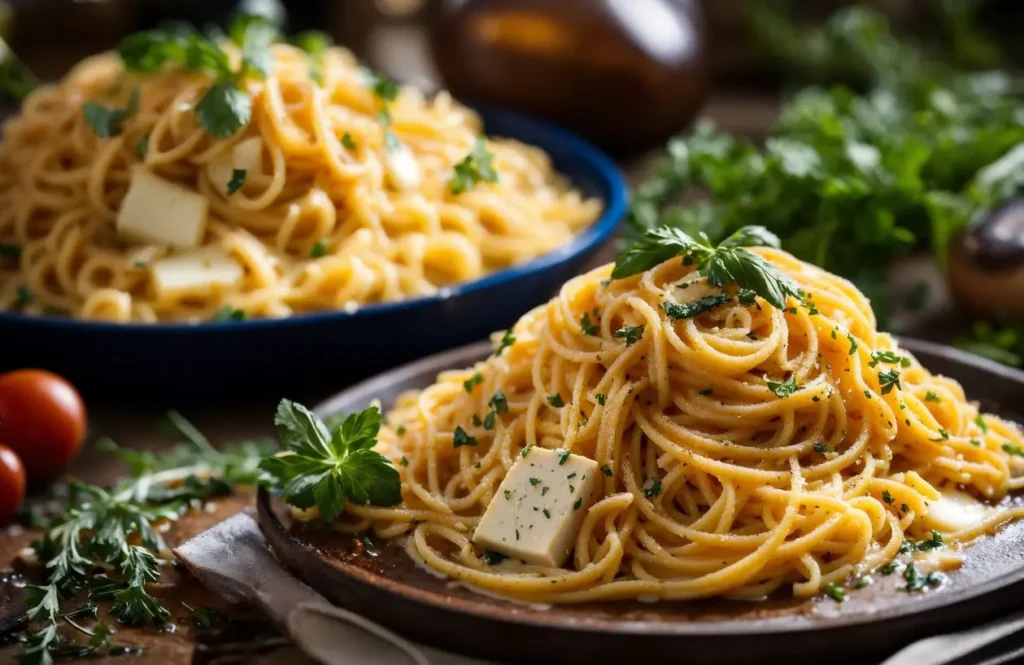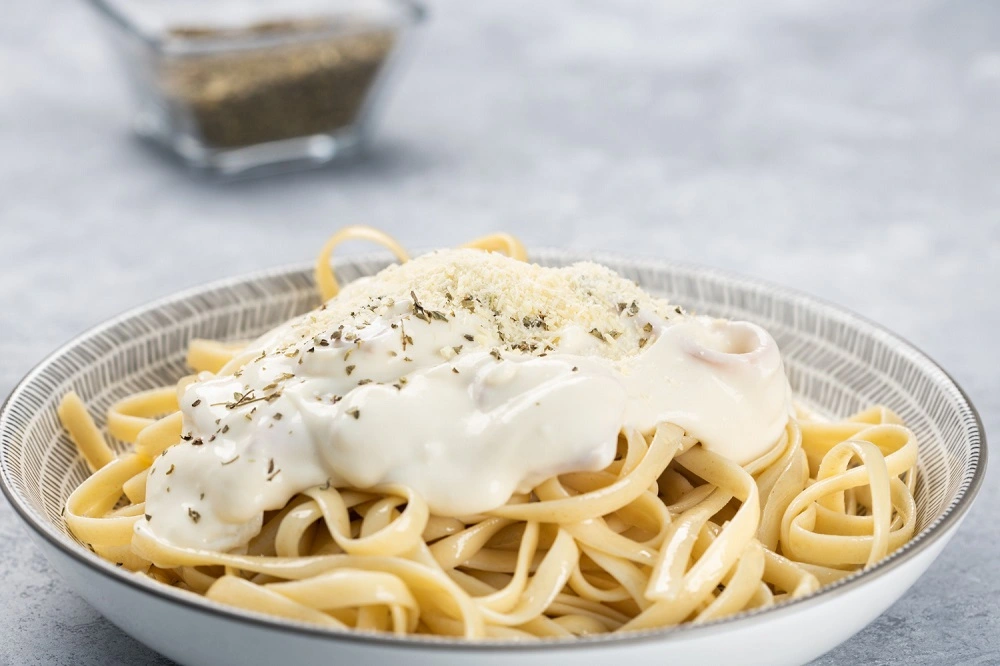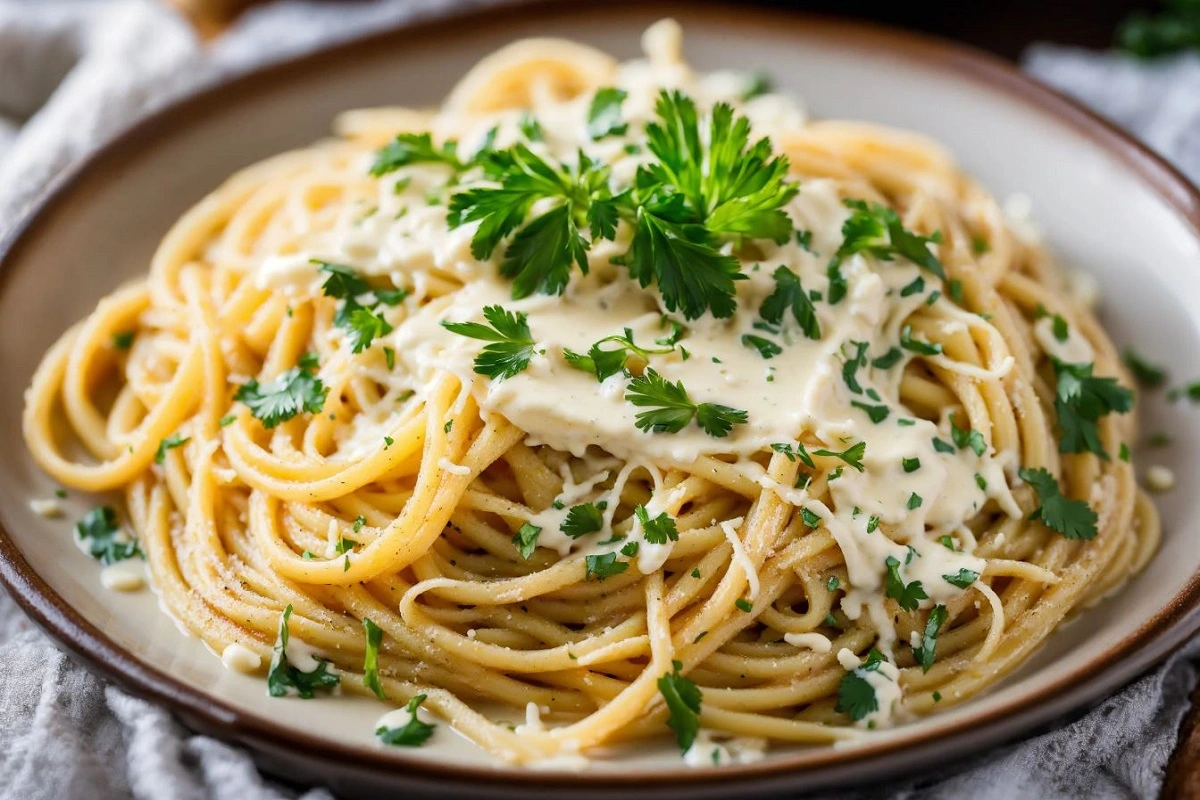Introduction to Brie Pasta
Ah, Brie Pasta—just the mention of it conjures up images of creamy, melt-in-your-mouth goodness that can turn a simple meal into a gourmet experience. For those who might be wondering, “What exactly is Brie Pasta?” let’s dive in. At its core, it’s a delightful dish that marries the rich, creamy texture of Brie cheese with the comforting familiarity of pasta. The appeal? It’s all about indulgence, flavor, and the joy of combining two culinary favorites into one delectable meal.
The Basics of Brie Cheese
Understanding Brie Cheese
Originating from France, Brie is a soft cheese named after the French region from which it originated. It’s easily recognizable by its creamy interior and edible white rind. Brie’s flavor profile can range from mild and buttery in young cheeses to more complex and earthy as it ages. This versatility makes Brie a fantastic ingredient in pasta dishes, adding a depth of flavor that’s hard to beat.
Why Brie Works Well in Pasta
The allure of this cheese in pasta creations stems from its ability to melt so beautifully. Upon warming, it turns exceptionally creamy and envelops the pasta with a richness that’s hard to find in other cheeses. This velvety texture, paired with its unique taste, transforms any pasta dish into a culinary delight.
Classic Brie Pasta Recipes
Linguine with Tomatoes, Basil, and Brie Overview

Imagine hot linguine tossed with fresh, ripe tomatoes, aromatic basil, and melted Brie—sounds like a dream, right? This classic recipe is a testament to the beauty of simplicity in cooking. The key is using high-quality ingredients: ripe tomatoes, fresh basil, and, of course, room-temperature Brie that melts perfectly into the pasta.
Variations on Brie Pasta
While the classic linguine recipe is a fantastic starting point, the world of Brie pasta is vast and varied. From adding grilled chicken or sautéed mushrooms for a protein boost to incorporating spinach or arugula for a green twist, the possibilities are endless. For those looking to keep it low-carb, substituting traditional pasta with zucchini noodles or spaghetti squash makes for a lighter yet equally satisfying dish.
Cooking Tips and Techniques
Best Practices for Cooking with Brie
To fully harness the creamy goodness of Brie in pasta, a few tips can go a long way. First, ensure the Brie is at room temperature before adding it to the pasta to achieve that desirable creamy texture. Also, consider the balance of flavors; Brie pairs wonderfully with ingredients that offer a hint of acidity or sweetness, like tomatoes or caramelized onions.
Pasta Cooking Techniques
Achieving the perfect al dente pasta is an art form. Start with plenty of boiling, salted water and keep testing the pasta towards the end of the cooking time to ensure it’s just right. When it comes to combining the pasta with the sauce, do it while the pasta is hot to allow the Brie to melt beautifully, coating each strand with creamy goodness.
Advanced Ideas
Creative Twists on Traditional Recipes

Once you’ve mastered the classic Brie Pasta, why not shake things up a bit? The culinary world is your oyster, and with Brie, the opportunities to innovate are boundless. Consider a summer pasta salad with Brie, peaches, and a balsamic glaze for a dish that sings of sunshine. Or, for a cozy winter meal, a baked penne with Brie, roasted butternut squash, and sage could be just the ticket. These creative twists not only add a seasonal flair but also introduce a delightful array of textures and flavors to your pasta repertoire.
Fusion Cuisine Inspirations
Fusion cuisine offers a playground for incorporating Brie into pasta dishes. Imagine a Brie Pasta with a twist of Asian flavors, like a creamy Brie and mushroom ramen. Or perhaps a Brie mac ‘n’ cheese with a touch of truffle oil and crispy breadcrumbs for a decadent fusion of French and American comfort foods. The key here is to balance the rich creaminess of Brie with other elements to create a harmonious dish that’s both innovative and irresistible.
Pairing Wines with Brie Pasta
Selecting the Right Wine
Pairing wine with Brie Pasta can elevate your dining experience to a whole new level. For enthusiasts looking to expand their pairing knowledge, our guide to the perfect sizzling flavor with pepper lunch recipes might inspire your next culinary adventure. The creamy texture and rich flavor of Brie call for wines that offer a balance of acidity, fruitiness, and body. White wines like Chardonnay or Sauvignon Blanc can complement the creaminess of Brie without overwhelming the dish. For those who prefer red, a light Pinot Noir or a Beaujolais offers the perfect counterbalance to the richness of the cheese with their bright acidity and fruit-forward profiles.
Taste Pairing Principles
The art of wine pairing with Brie Pasta revolves around matching the intensity of the dish with that of the wine. A rule of thumb is to consider the dish’s main flavor profiles—creamy, rich, and possibly earthy from the Brie—and select a wine that offers contrast or complements these elements. For an in-depth guide on pairing wine with pasta, Wine Folly offers a comprehensive resource that demystifies the process, ensuring your meal is a hit from the first bite to the last sip.
FAQs
Frequently Asked Questions
- Best type of Brie for pasta? Opt for a creamy, mild Brie to ensure it melts into the pasta beautifully without overpowering the other ingredients.
- Can I use pre-made sauces? Absolutely, but consider enhancing them with fresh ingredients like basil or tomatoes to elevate the dish.
- How to store leftovers? Brie pasta is best enjoyed fresh, but if you have leftovers, store them in an airtight container in the refrigerator and enjoy within a day or two for the best quality.
Seasonal Brie Pasta Inspirations
The beauty of Brie Pasta lies in its versatility across seasons, offering a canvas to incorporate seasonal ingredients for a year-round appeal.
Spring: Asparagus and Lemon Brie Pasta
Spring brings a bounty of fresh produce, making it the perfect time to lighten up your pasta dishes. A Brie Pasta with blanched asparagus and a zest of lemon offers a refreshing twist. The crispness of asparagus and the citrusy spark of lemon zest cut through the richness of Brie, creating a balanced dish that sings of spring.
Summer: Cherry Tomato and Basil Brie Pasta
Summer’s warmth ripens tomatoes to perfection, making them an ideal addition to your Brie pasta. Combine halved cherry tomatoes and fresh basil with melted Brie for a dish that’s as colorful as it is delicious. This combination not only celebrates the flavors of summer but also adds a vibrant visual appeal to your table.
Fall: Pumpkin and Sage Brie Pasta
When the air turns crisp and the leaves start to fall, it’s time to introduce the cozy flavors of autumn into your pasta. A pumpkin and sage Brie pasta, with its rich, earthy tones and creamy texture, embodies the essence of the season. The sweetness of pumpkin complements the creamy Brie, while sage adds a hint of warmth and depth.
Winter: Mushroom and Thyme Brie Pasta
Winter calls for hearty, comforting dishes, and a mushroom and thyme Brie pasta fits the bill perfectly. The umami-rich flavors of sautéed mushrooms paired with the aromatic thyme create a soul-warming dish that’s ideal for chilly evenings. This dish not only provides comfort but also adds a touch of elegance to your winter dining.
The Art of Choosing the Perfect Brie for Pasta
Selecting the right Brie is crucial for achieving the perfect Brie Pasta. Here’s how to choose the best Brie for your dish:
Texture and Ripeness
The texture of Brie can range from firm to creamy, depending on its age. For pasta dishes, a creamier Brie that melts well is ideal. Check the ripeness by gently pressing the center of the cheese; it should yield slightly to pressure.
Flavor Profile
Brie’s flavor can vary from mild to robust. Consider the other ingredients in your pasta dish when selecting your Brie. A milder Brie complements delicate flavors like lemon and asparagus, while a more mature Brie can stand up to stronger flavors like roasted pumpkin or sautéed mushrooms.
Origin and Quality
The origin of Brie can also influence its flavor and quality. Brie from France, particularly Brie de Meaux or Brie de Melun, is known for its superior quality and authenticity. However, many local cheesemakers produce excellent Brie as well. Opt for high-quality Brie from reputable sources to ensure the best outcome for your pasta dishes.
Incorporating Global Flavors
Broadening the scope of this creamy pasta dish elevates it to a global culinary journey. Integrating flavors from across the globe, you’re able to craft a fusion that delights the senses and demonstrates the adaptability of creamy cheese in pasta recipes.
Mediterranean Magic: Olive Tapenade and Roasted Red Peppers
Embrace the vibrant flavors of the Mediterranean by adding olive tapenade and roasted red peppers to your Brie pasta. The salty depth of the tapenade, combined with the sweet smokiness of roasted red peppers, creates a dish that’s bursting with flavor. This fusion not only elevates the dish but also brings a touch of the Mediterranean sun to your table.
Asian Twist: Soy-Glazed Shiitake and Scallions
For an Asian twist, try adding soy-glazed shiitake mushrooms and scallions to your Brie pasta. The umami-rich soy sauce complements the earthy shiitake mushrooms, while the scallions add a fresh, oniony crunch. This East-meets-West creation is a testament to the adaptability of Brie, seamlessly blending with diverse culinary traditions.
Latin Flair: Corn, Cilantro, and Lime
Inject a Latin flair into your Brie pasta with the addition of sweet corn, fresh cilantro, and a squeeze of lime. The sweetness of the corn pairs beautifully with the creamy Brie, while the cilantro and lime cut through the richness with their zesty freshness. This combination brings a lively, colorful twist to the classic dish.
Tips for Perfect Pasta Every Time
Achieving the perfect pasta dish goes beyond the ingredients; technique plays a crucial role. Here are some tips to ensure your Brie Pasta is flawless every time:
Salt the Water
Salting the pasta water is essential for flavor. The water should taste as salty as the sea, providing your pasta with its initial seasoning.
Reserve Pasta Water
Before draining your pasta, reserve a cup of the pasta water. The starchy water is a secret weapon for creating a silky sauce that clings beautifully to the pasta, enhancing the creamy texture of the Brie.
Gentle Heat for Brie
When melting Brie into your pasta, use gentle heat to avoid separating the fats and proteins, which can result in a grainy texture. Discover more about perfecting pasta dishes in our ultimate guide to baking manicotti, where we delve into the nuances of pasta preparation. Low and slow is the mantra for a smooth, creamy sauce.
Fresh is Best
Whenever possible, use fresh pasta. Its texture and ability to absorb flavors elevate the dish, making the Brie and other ingredients shine.
Conclusion
In the culinary realm, few creations match the comfort, adaptability, and pure delight of this creamy pasta. Its journey from modest origins to becoming a dish that blends global flavors is a tribute to the magic of combining straightforward ingredients into something truly special. Our exploration of this cherished dish, from seasonal variations and ideal wine companions to the integration of international tastes and mastering essential cooking methods, reveals it to be more than just food—it’s a culinary adventure.
Navigating through its various forms, from traditional recipes to innovative, fusion-inspired takes, highlights its broad appeal. The embrace of its creamy essence, the zest of fresh herbs, the richness of seasonal produce, and the daring incorporation of worldwide flavors open up a universe of gastronomic opportunities. Each twist not only contributes a new layer to its narrative but also encourages us to unleash our culinary creativity.
Furthermore, the shared advice and insights throughout this journey act as more than just a blueprint for crafting the ultimate creamy pasta dish; they inspire a heartfelt approach to cooking. Selecting the ideal cheese, understanding the nuances of pasta preparation, and finding the perfect wine complement each play a crucial role in enhancing the meal, turning a simple dish into an extraordinary culinary experience.
